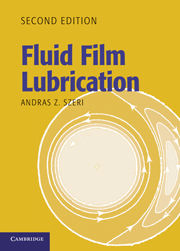Book contents
- Frontmatter
- Contents
- Preface to the Second Edition
- Preface to the First Edition
- Chapter 1 Introduction
- CHAPTER 2 Basic Equations
- CHAPTER 3 Thick-Film Lubrication
- CHAPTER 4 Dynamic Properties of Lubricant Films
- CHAPTER 5 Effects of Fluid Inertia
- CHAPTER 6 Flow Stability and Transition
- CHAPTER 7 Turbulence
- CHAPTER 8 Elastohydrodynamic Lubrication
- CHAPTER 9 Thermal Effects
- CHAPTER 10 Lubrication with Non-Newtonian Fluids
- CHAPTER 11 Gas Lubrication
- CHAPTER 12 Molecularly Thin Films
- CHAPTER 13 Biotribology
- Index
- References
CHAPTER 13 - Biotribology
Published online by Cambridge University Press: 05 June 2012
- Frontmatter
- Contents
- Preface to the Second Edition
- Preface to the First Edition
- Chapter 1 Introduction
- CHAPTER 2 Basic Equations
- CHAPTER 3 Thick-Film Lubrication
- CHAPTER 4 Dynamic Properties of Lubricant Films
- CHAPTER 5 Effects of Fluid Inertia
- CHAPTER 6 Flow Stability and Transition
- CHAPTER 7 Turbulence
- CHAPTER 8 Elastohydrodynamic Lubrication
- CHAPTER 9 Thermal Effects
- CHAPTER 10 Lubrication with Non-Newtonian Fluids
- CHAPTER 11 Gas Lubrication
- CHAPTER 12 Molecularly Thin Films
- CHAPTER 13 Biotribology
- Index
- References
Summary
The term biotribology, to cover “all aspects of tribology related to biological systems,” was coined only four decades ago (Dowson and Wright, 1973); however, investigations into friction, lubrication and wear of biological tissues date back much further. As early as the nineteenth century, Young (1809) and Poiseuille (1840) studied the flow properties of blood, essential today for the design of artificial organs. Reynolds likened lubrication of articulated joints to lubrication of machine elements. In the last sentence of his classical paper, Reynolds remarked that hydrodynamic lubrication “is as fundamental to animal mechanics as the lubricating action of the journal is to mechanical contrivances” (Reynolds, 1886). Jin and Dowson (2005) listed six areas of biotribology in addition to lubrication of joints and of red blood cells in capillaries, such as wear of dentures and the tribology of contact lenses. Nevertheless, in this chapter, we restrict ourselves to one topic only, the lubrication of articular joints.
Lubrication of Articular Joints
The loading cycle to which an articular joint is subjected is complex and the demands this places on the joint are numerous (Paul, 1967). For example, across the hip the cycle displays two force maxima, at heal strike (HS) and at toe-off (TO), as illustrated in Figure 13.1, the latter reaching four times the body weight. As additional complications, the forces that operate within the joint are three dimensional, time dependent and vary with speed and length of stride, and, of course, vary from person to person.
- Type
- Chapter
- Information
- Fluid Film Lubrication , pp. 511 - 542Publisher: Cambridge University PressPrint publication year: 2010

